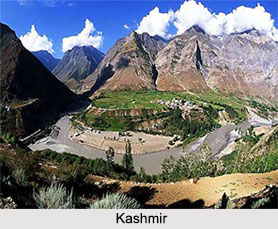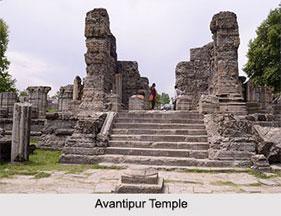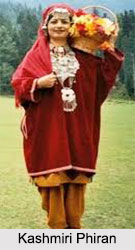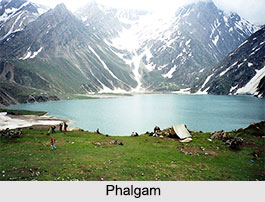 Kashmir and Kashmir Valley in the State of Jammu and Kashmir is one of the most beautiful places in all of India. It is here in this beautiful valley that lofty hills, snow-capped mountains, beautiful glaciers, flat country interspersed with fields, archaeological sites from the time of Indus Valley Civilisation and fruit gardens are all exhibited close to each other and provide for everybody`s taste and interest.
Kashmir and Kashmir Valley in the State of Jammu and Kashmir is one of the most beautiful places in all of India. It is here in this beautiful valley that lofty hills, snow-capped mountains, beautiful glaciers, flat country interspersed with fields, archaeological sites from the time of Indus Valley Civilisation and fruit gardens are all exhibited close to each other and provide for everybody`s taste and interest.
Location of Kashmir
Kashmir is 84 miles long and 24 miles broad with an area of about 4,500 sq. It lies at an altitude of 5,200ft. The main portion of the valley of Kashmir, so much renowned, is the central part of the Kashmir Province and is enclosed by Pansal, Pir Punjal Range, Darwar, Harmukh and Sonamarg mountains. The Jhelum River for the major portion of its course in the valley runs in a serpentine curve and on its bank stands Srinagar, the Capital of Kashmir.
History of Kashmir
 History of Kashmir is common with the history of Jammu and Kashmir, as it formed a part of the same province and was under the same rule. It is held in the Mahabharata that the Kambojas ruled Kashmir during the epic period with a Republican system of government. Kashmir was one of the important places of Hinduism in the first half of the first millennium and later on went on to become an important centre of Buddhism. Emperor Ashoka is said to have founded the capital of Kashmir, Shrinagari, which now lies in ruins along the outskirts of the modern-day Srinagar. For a long time, Kashmir was a stronghold of Buddhism and Buddhist learning. Later on in the ninth century, Kashmir Shaivism was in vogue in the valley. Kashmir subsequently came under Muslim rule and the first Muslim ruler of Kashmir was Shah Mir, who started the Salatin-i-Kashmir or Swati dynasty. The Muslim monarchs ruled Kashmir for the next five centuries and while some of the Muslim rulers like Sultan Zain-ul-Abidin were extremely tolerant of other communities, some others displayed extreme intolerance. The Muslim rule in Kashmir included the reign of the Mughals, who ruled from 1526 until 1751, then the Afghan Durrani Empire that ruled from 1747 until 1820. By the early nineteenth century, Kashmir had passed into the hands of the conquering Sikhs, annexed by Maharaja Ranjit Singh. In the year 1846, the region was bought over from the British by the Dogras, under the rule of Gulab Singh, and they became the new rulers under the protection of the British Crown. Following the end of British colonial rule, Kashmir remains a much-disputed territory rifled with problems of border issues and territorial disputes.
History of Kashmir is common with the history of Jammu and Kashmir, as it formed a part of the same province and was under the same rule. It is held in the Mahabharata that the Kambojas ruled Kashmir during the epic period with a Republican system of government. Kashmir was one of the important places of Hinduism in the first half of the first millennium and later on went on to become an important centre of Buddhism. Emperor Ashoka is said to have founded the capital of Kashmir, Shrinagari, which now lies in ruins along the outskirts of the modern-day Srinagar. For a long time, Kashmir was a stronghold of Buddhism and Buddhist learning. Later on in the ninth century, Kashmir Shaivism was in vogue in the valley. Kashmir subsequently came under Muslim rule and the first Muslim ruler of Kashmir was Shah Mir, who started the Salatin-i-Kashmir or Swati dynasty. The Muslim monarchs ruled Kashmir for the next five centuries and while some of the Muslim rulers like Sultan Zain-ul-Abidin were extremely tolerant of other communities, some others displayed extreme intolerance. The Muslim rule in Kashmir included the reign of the Mughals, who ruled from 1526 until 1751, then the Afghan Durrani Empire that ruled from 1747 until 1820. By the early nineteenth century, Kashmir had passed into the hands of the conquering Sikhs, annexed by Maharaja Ranjit Singh. In the year 1846, the region was bought over from the British by the Dogras, under the rule of Gulab Singh, and they became the new rulers under the protection of the British Crown. Following the end of British colonial rule, Kashmir remains a much-disputed territory rifled with problems of border issues and territorial disputes.
Geography of Kashmir
 The climate of Kashmir is healthy and invigorating, and the region is full of flowers and fruit blossoms. The Kashmir valley is famous for fruits which are renowned for their durability, juiciness and flavour throughout the whole world. Kashmir is well-known for its production of excellent fruits such as apples, peaches, pears, plums, cherries, strawberries and various other fruits which grow in Europe. Jams are made from many fruits. Tea, cinchona and hops are also cultivated. Kashmir produces many crops, the chief being rice, maize, wheat, bailey, millets and pulses which can thrive without much rain due lo great humidity in the valley.
The climate of Kashmir is healthy and invigorating, and the region is full of flowers and fruit blossoms. The Kashmir valley is famous for fruits which are renowned for their durability, juiciness and flavour throughout the whole world. Kashmir is well-known for its production of excellent fruits such as apples, peaches, pears, plums, cherries, strawberries and various other fruits which grow in Europe. Jams are made from many fruits. Tea, cinchona and hops are also cultivated. Kashmir produces many crops, the chief being rice, maize, wheat, bailey, millets and pulses which can thrive without much rain due lo great humidity in the valley.
Culture of Kashmir
Culture of Kashmir is a beautiful blend of the various interactions with varied races as well as the exigencies of the environment. The Kashmiri culture has a mixed character, being an ingredient of Hindu, Muslim and Buddhist Elements. As regards the dress of Kashmiris, it is mostly the phiran- a long loose gown buttoning at the neck and falling to the ankles. In winter it is made of wool and in summer of cotton. There is very little difference between the phiran worn by men and women. A pyjama of the loose type is generally worn under the phiran and this is all the dress of an average villager. The women wear a skull cap surrounded by a fillet of red colour in the case of Muslim and a fillet of white cloth in the case of Pandit women. A shawl or a white chaddar thrown gracefully over the head and shoulders, more as a protection from the sun than to hide the features, completes their headgear. Men wear a turban as a sign of respectability and affluence. It is commonly worn by the inhabitants of cities and big towns. The ordinary peasant is content with wearing the long pointed skull cap. In winter a kangri is taken under the phiran to keep oneself warm. It consists of an earthen jar of about six inches diameter covered with a basket of wickerwork. Charcoal cinders of a special type are put in it to give a constant and continuous heat. As regards their food habits, the staple food of the Kashmiris is rice. They take plenty of vegetables but the favourite dish is the hak or karam sag. In the cities mutton is consumed in large quantities but in the villages it is still a luxury reserved only for festive occasions. Although being inhabitants of a cold country, Kashmiris abhor the use of intoxicating drinks. They have, however, found a cheap and harmless alternative in tea which they take so often. Its preparation is also quite different, salt being used instead of sugar. Green tea leaves are boiled and to give it a pink colour a little soda bicarb is added. This is the nun chai or salt tea. The other kind of tea reserved mostly for festive occasions is the Kahwah, made with saffron and spices. The samovar is generally steaming throughout the day.
Tourism in Kashmir
Kashmir is a real haven for tourists as it is a place of breathtaking beauty. Some of the most visited places in Kashmir are the Mughal Gardens, Pahalgam, Gulmarg, the Houseboats etc. The Houseboat is the summer haunt of visitors. Kashmir is noted for unique architectural and archaeological monuments and the hill stations. Elements of Buddhist, Muslim as well as Hindu rule can be seen here. Some of the important archaeological remains are at Awanti Pur, Martand temple at Mattan, Budshah`s Tomb at Srinagar, the caves at Bhumju the ruins at Narasthan, the ancient Hindu Pandrethan Temple, the Temple ruins at Pattan, the ancient temple at Payech and Takht-i-Suliman and the Shanker Acharaya Temple. Other architectural specimens are to be found at Ushakar, at Harwan.
Scope of Tourism in Kashmir
Kashmir and Kashmir Valley possesses a wide variety of picturesque sights and there are many lakes in Kashmir situated at high altitudes both among the mountains and in the valley. Its amazing wealth of flowers and fruit blossoms is indescribably beautiful, and the grand panorama of surrounding snow-capped mountains, with peaks ascending to about 28,000 feet, is one of the grandest in the world. The natural beauty, the scenery of the mountains and lowlands is enhanced by the gorgeous display of blossoms on immense number of fruit-bearing trees of many varieties.
Related Articles
Jammu and Kashmir, Indian State
Costumes of Jammu and Kashmir
Early History of Kashmir Valley
Culture of Jammu and Kashmir



















